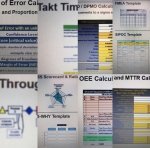 |
|
Kaizen is a Japanese word and in this context it refers to continuous improvement with the involvement of all stakeholders and layers of the organization. Dr. Shigeo Shingo excelled at systematically finding the root causes and permanently correcting them. He taught others how to identify root causes and identify waste, while making it enjoyable.
There are those that continuously improve and those that continuously improve faster. Continuous improvement is often not enough, many are always improving and survival requires it as the economy globalizes and competition intensifies.
The video below is an example of a well-coordinated Kaizen event from start to finish. Interest is created, the material is kept simple, fun, and most importantly....results.
Speaking in terms of the long run, Kaizen is a method of problem solving to continuously improve in the most general sense. It is a never-ending philosophy that starts with understanding the current state.
Kaizen requires the engagement of the workers, suppliers, and all layers of the organization. The key is seeing and understanding the problems rather
than acting on assumptions on how the process should work. Gemba walks
and actually observing the process will remove subjectivity and bias.
Thorough
root cause understanding and control, relentless focus on defect
prevention, targeting the vital few instead of attacking the trivial
many (Pareto principle), waste elimination (not just identification and reduction), then repeat the cycle. These are tactics that accelerate the Kaizen process.
It
is better to take ample time to completely understand the problem than
to start immediately on random improvements. Study and analyze carefully
but once the problem is understood and ideas are ready then implement quickly and implement across the company, process, or area.
The Kaizen Blitz
The philosophy is often used to describe a short term event usually a few days to a couple weeks, that involves quick, rapid, energized improvements.
Kaizen blitzes can be done in the office, on systems or software, and on the floor. While it is important not to measure people directly to numbers on a continuous basis, each project should have benchmark metrics and strive to improve each of them throughout the event.
Before a Kaizen event is started the participants need an education of the basic Lean Manufacturing and root cause analysis principles.
There should also be a lot of hype built around an event and it should take place in the area affected with the people affected.
It can't be emphasized enough the importance of engaging those that have a direct stake in the project. Avoid computers and staying behind closed doors or with just a few from management.
Prepare a daily schedule and be a good host. Provide adequate food, supplies, and other resources so the team is equipped. This will allow them to make rapid, simple, inexpensive, trials and improvements.
Meet and report out on the day's results before adjourning. Keep everyone unified and driving aggressively toward a goal.
As a host and GB/BB, pay attention to every detail. Show the team and participants you are prepared, committed, and genuinely engaged. This sets the example you want to them to embrace throughout the event. Without it, success is already at risk.
Typical supplies for a Blitz include:
- Pens, pencils, markers, and other writing utensils
- Red tags (for the 5S component)
- Tape measures
- Tape
- Paint and painting supplies
- Paper
- Signage material
- Stopwatch
- Rags, brooms, dustpans, recycle bins
- Cleaning supplies
- Tools and basic hardware
- Cable ties
- Lights
- Laminator and laminating supplies
- Dry erase board
Having maintenance on stand-by is recommended depending on the event. They may be called upon to quickly fabricate, remove, or modify items for the team.
They should be available to work overnight while the team has adjourned and improvements have been identified for the next day's trials and review.
The team may need IT on stand-by to quickly generate and mine data as it becomes necessary. Most of this should be done in advance.
Management should dress down for the event and join in on the change; get involved and roll up the sleeves. Working side-by-side will serve more dividends than just achieving a metric for the event. Part of a successful event includes raising morale, walking the talk, setting an example, building relationships, and learning more about the everyday activities in the workplace.
Kaizen - Training Slides
This collection of Green and Black training slides provides additional insight into the topic of Kaizen as part of the package of over 1,000 slides. Kaizen is critical component of the IMPROVE phase and any Lean Manufacturing program. A successful event can quickly build momentum and make believers out of the Six Sigma program, you, and the project.
Click here to learn more (also comes with a Practice Exam).
Focus on IMPLEMENTATION
It does not require statistical approaches, complex graphs and charts, although they can be used to help quantify and find key process input variables.
- Keep it simple, clear, and refrain from being number bound and alienating the team members with unnecessary jargon and analysis.
- A Kaizen event won't fix everything at once, usually they are focused on a specific product, machine, area, or process and the blitz focuses each day on the same target.
- The goal is the make that area the best it can practically be and show what can be done. The challenge is to get it started and controlled and then expand the improvements across the rest of the machines, areas, or processes. Don't try to fix it all at once.
- The status quo and traditional paradigms must be challenged. Being creative and thinking out of the box are easily understood but require brainstorming and idea generation tactics to optimize the improvements.
- Improvements do not have to be expensive and perfect the first time, the team needs to apply the principles and sample, run trials, and determine the effect. Each improvement should be controlled and build on the previous.
- At the end of each day, the metrics are tallied and the team reports on their results. Go after more improvements the next day, generate new ideas, and implement. Always focus on implementation even if it is not perfect.
Does the work area TALK to you?
Some of the most significant benefits are found in education and helping others recognize waste and non value-added steps.
Find ways to make the work area (hospital, office, factory, store, assembly line) "speak" to you and others in the company.
Apply the tactics of Visual Management, expose problems, make them visual, and discuss them. Anyone should be able to walk through an area after a Kaizen Blitz and have a good understanding of what is occurring, status, problems, and if they are winning or losing at that moment.
After the Blitz
- Some of the ideas wont be done in the short amount of time that was dedicated to the blitz. Review these with the company leadership for future consideration.
- Display the BEFORE and AFTER pictures and data as it is possible.
- Give credit to the team members.
- Reflect on the good and bad and make improvements to the Blitz process.
- Schedule reviews to ensure the gains are sustained...such as 30, 60, 90 day reviews.
Often times there is an idea that is trialed on one area, machine, or form, etc. If this idea is successful, ensure to implement it across any others where it makes sense. This may take more time that you have allotted; ensure the leaders of the company are aware.
Templates, Statistics Tables, and Calculators
Return to the Six-Sigma-Material Home Page
Recent Articles
-
Process Capability Indices
Oct 18, 21 09:32 AM
Determing the process capability indices, Pp, Ppk, Cp, Cpk, Cpm -
Six Sigma Calculator, Statistics Tables, and Six Sigma Templates
Sep 14, 21 09:19 AM
Six Sigma Calculators, Statistics Tables, and Six Sigma Templates to make your job easier as a Six Sigma Project Manager -
Six Sigma Templates, Statistics Tables, and Six Sigma Calculators
Aug 16, 21 01:25 PM
Six Sigma Templates, Tables, and Calculators. MTBF, MTTR, A3, EOQ, 5S, 5 WHY, DPMO, FMEA, SIPOC, RTY, DMAIC Contract, OEE, Value Stream Map, Pugh Matrix

Site Membership
LEARN MORE
Six Sigma
Templates, Tables & Calculators
Six Sigma Slides
Green Belt Program (1,000+ Slides)
Basic Statistics
Cost of Quality
SPC
Control Charts
Process Mapping
Capability Studies
MSA
SIPOC
Cause & Effect Matrix
FMEA
Multivariate Analysis
Central Limit Theorem
Confidence Intervals
Hypothesis Testing
Normality
T Tests
1-Way ANOVA
Chi-Square
Correlation
Regression
Control Plan
Kaizen
MTBF and MTTR
Project Pitfalls
Error Proofing
Z Scores
OEE
Takt Time
Line Balancing
Yield Metrics
Sampling Methods
Data Classification
Practice Exam
... and more




